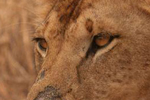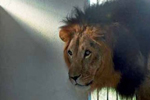
Female lion with wildebeest kill in Tanzania. Photo by: Rhett A. Butler.
For a long time male lions were derided as the lazy ones in the pride, depending on females for the bulk of hunting and not pulling their weight. Much of this was based on field observations—female lions hunt cooperatively, often in open savannah, and therefore are easier to track at night. But new research in Animal Behaviour is showing that males are adroit hunters in their own right, except prickly males hunt alone and use dense vegetation as cover; instead of social hunting in open savannah, they depend on ambushing unsuspecting prey.
In order to understand how lions, both male and female, use vegetation in hunting, scientists took data from GPS collared lions in South Africa’s Kruger National Park and then took to the air. Using advanced airplane sensors, which have been employed to great effect in the Amazon to measure vegetation, Greg Asner and Scott Loarie with the Carnegie Institution for Science mapped the vegetation around known lion kill sites, essentially creating a 3-D image of the lion’s view as it struck. They found that male lions took down prey in areas with much shorter sight-lines (averaging 3.4 meters) as opposed to group-hunting females (8.6 meters). This means that lone males were likely depending on vegetation as cover before springing on their victims.
“Locations where male lions killed both small and large prey had shorter lines-of-sight than locations where they rested. In contrast, lines-of-sight distances at locations where female lions killed both small and large prey did not differ significantly from those at locations where they rested,” the researchers write.
Employing both GPS field studies and aerial mapping, the study is a creative use of new technologies to solve old mysteries. But, in addition, the findings—that males depend on thick vegetation for hunting—may have major conservation implications.
“This study suggests that changes to vegetation structure, such as through fire management, could greatly alter the balance of predators and prey,” Scott Loarie said.
Lions are currently listed as Vulnerable by the IUCN Red List and a number of recent studies have shown that Africa’s top predator has suffered major population declines. In fact a study last year estimated that lion populations have fallen by 68 percent in the last 50 years alone. Scientists say habitat loss, prey decline, and lion-human conflict have caused the bulk of the decline. But it’s also possible that as lions depend on more-and-more on heavily managed protected areas for security from rising human populations, some male lions may find it harder to hunt.
“With large mammals increasingly confined to protected areas, understanding how to maintain their habitat to best support their natural behavior is a critical conservation priority,” Asner said.
The new findings also may also be a cautionary tale for those considering re-introducing lions into parks and private reserves.
“Pressure to offer charismatic viewing opportunities to tourists […] Despite being indigenous to most of these reserves, lions are returning to very different landscapes, namely those that are increasingly being fenced and fragmented with altered hydrological and fire regimes,” the researchers write.

Captive male lion. Photo by: Rhett A. Butler.
CITATION: Scott Loarie, Craig Tambling, and Greg Asner. Lion hunting behaviour and vegetation structure in an African savanna. Animal Behaviour. 2014. http://dx.doi.org/10.1016/j.anbehav.2013.01.018
Related articles
Forgotten lions: shedding light on the fate of lions in unprotected areas

(03/18/2013) African lions (Panthera leo) living outside of protected areas like national parks or reserves also happen to be studied much less than those residing within protected areas, to the detriment of lion conservation initiatives. In response to this trend, a group of researchers surveyed an understudied, unprotected region in northwestern Mozambique called the Tete Province, whose geography and proximity to two national parks suggests a presence of lions.
The end of wild Africa?: lions may need fences to survive

(03/06/2013) In order for dwindling lion populations to survive in Africa, large-scale fencing projects may be required according to new research in Ecology Letters. Recent estimates have put lion populations down to 15,000-35,000, a massive drop from a population that was thought to be around 100,000 in 1960. The worsening plight of lions have pushed the researchers to suggest what is likely to be a controversial proposal: fence the top predators in.
Geneticists discover distinct lion group in squalid conditions

(02/04/2013) They languished behind bars in squalid conditions, their very survival in jeopardy. Outside, an international team of advocates strove to bring worldwide attention to their plight. With modern genetics, the experts sought to prove what they had long believed: that these individuals were special. Like other cases of individuals waiting for rescue from a life of deprivation behind bars, the fate of those held captive might be dramatically altered with the application of genetic science to answer questions of debated identity. Now recent DNA analysis has made it official: this group is special and because of their scientifically confirmed distinctiveness they will soon enjoy greater freedom.
Lion population falls 68 percent in 50 years

(12/04/2012) African lions, one of the most iconic species on the planet, are in rapid decline. According to a new study in Biodiversity Conservation, the African lion (Panthera leo leo) population has dropped from around 100,000 animals just fifty years ago to as few as 32,000 today. The study, which used high resolution satellite imagery to study savannah ecosystems across Africa, also found that lion habitat had plunged by 75 percent.
Africa’s great savannahs may be more endangered than the world’s rainforests

(12/04/2012) Few of the world’s ecosystems are more iconic than Africa’s sprawling savannahs home to elephants, giraffes, rhinos, and the undisputed king of the animal kingdom: lions. This wild realm, where megafauna still roam in abundance, has inspired everyone from Ernest Hemingway to Karen Blixen, and David Livingstone to Theodore Roosevelt. Today it is the heart of Africa’s wildlife tourism and includes staunch defenders such as Richard Leakey, Michael Fay, and the Jouberts. Despite this, the ecosystem has received less media attention than imperiled ecosystems like rainforests. But a ground-breaking study in Biodiversity Conservation finds that 75 percent of these large-scale intact grasslands have been lost, at least from the lion’s point of view.
Illegal hunting threatens iconic animals across Africa’s great savannas, especially predators

(10/25/2012) Bushmeat hunting has become a grave concern for species in West and Central Africa, but a new report notes that lesser-known illegal hunting in Africa’s iconic savannas is also decimating some animals. Surprisingly, illegal hunting across eastern and southern Africa is hitting big predators particularly hard, such as cheetah, lion, leopard, and wild dog. Although rarely targets of hunters, these predators are running out of food due to overhunting and, in addition, often becoming victims of snares set out for other species.